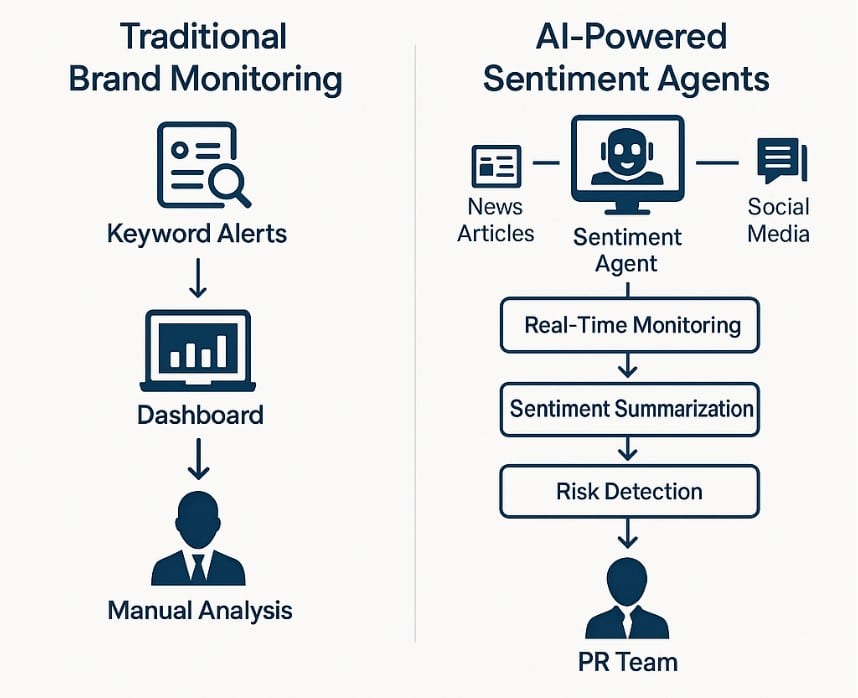There was a time when a PR crisis began with a headline. Today, it can start with a tweet.
Modern brand reputation management lives in a 24/7 media cycle that doesn’t just include major outlets but also micro-influencers, Reddit threads, TikTok duets, anonymous Glassdoor reviews, and satellite communities that traditional monitoring tools often miss. The signals are everywhere, and they move fast.
PR pros have long relied on dashboards, keyword alerts, and manual monitoring to make sense of this fragmented landscape. But those systems are breaking under the weight of volume, velocity, and volatility. The sheer number of touchpoints makes it nearly impossible to catch every signal that matters, or to understand its emotional tone in context.
This is where AI-powered sentiment agents come in.
These AI tools are part of a broader wave of AI agents in business that automate complex, context-driven tasks, from customer support to brand reputation monitoring, allowing companies to respond faster and smarter. They don’t just scan for mentions. They synthesize tone, context, and trend patterns in real time, flagging reputational risks before they explode and surfacing emerging sentiment themes before they hit the mainstream radar.
In this piece, we’ll explore how sentiment agents are redefining brand monitoring, the system design required to make them work, and what this shift means for PR teams trying to stay ahead of perception before it becomes a crisis.

Traditional Brand Monitoring Isn’t Fast (or Smart) Enough
Today’s monitoring tools often rely on keyword alerts or static dashboards that require human interpretation. They surface what is being said, but not how it’s being said or why it matters right now.
Three big challenges have emerged:
- Signal overload: Even mid-sized brands can generate thousands of social and media mentions per week across dozens of platforms.
- Sentiment ambiguity: Sarcasm, slang, memes, and local dialects make it difficult to interpret emotion using traditional sentiment classifiers.
- Delayed insight: By the time a pattern becomes clear to a human analyst, a negative narrative may already be trending.
Manual monitoring can’t keep up. And legacy tools treat sentiment analysis like a scorecard rather than a living signal.
Enter Agent AI: Always-On, Context-Aware, and Proactive
Sentiment agents are a class of autonomous AI designed to interpret the emotional meaning behind brand mentions and track how that meaning evolves over time. Unlike traditional tools that simply tag posts as “positive” or “negative,” these agents:
- Understand sarcasm and subtext using advanced LLMs
- Track sentiment change over time by topic or campaign
- Flag anomalous emotion shifts or volume spikes for immediate review
- Categorize sentiment by stakeholder group (e.g., journalists, consumers, investors)
These aren’t just monitoring tools. They’re watchdogs with empathy circuits.
Real-Time Monitoring Across Platforms
At the core of these systems is an always-on listener agent that taps into APIs, RSS feeds, public databases, and streaming services. This agent ingests:
- News articles and headlines
- Social media posts, replies, and threads
- YouTube/TikTok captions and comments
- Review platforms (G2, Glassdoor, Amazon)
- Forums and community hubs like Reddit or Hacker News
Using streaming NLP pipelines and distributed crawlers, these agents continuously process new data without manual intervention.
Key advantage: You no longer rely on lagging alerts. You get a live feed of brand perception as it happens, contextualized, classified, and enriched by AI.
Sentiment Summarization With Contextual Intelligence
Traditional sentiment analysis often outputs a flat score, like “72% positive” or “Mixed.”
Sentiment agents go deeper.
How it works:
- A language interpretation agent applies LLMs trained to recognize tone, context, irony, and emotion.
- A summarization agent condenses sentiment trends over a time window (e.g., 48 hours) into human-readable insights.
- A topic-clustering agent groups sentiment by issue, so you can see that mentions of your CEO are trending positive, while your pricing model is causing friction.
Here’s an example of what a PR team might receive:
“Mentions of your Series B funding round were 84% positive, driven by excitement around your AI roadmap. However, a subset of comments on Reddit and LinkedIn flagged concerns about leadership turnover, with a 16% increase in negative sentiment compared to the prior week.”
You don’t just get a score. You get a narrative and a signal on where to investigate next.
Early Warning Detection of Reputational Risk
Perhaps the most powerful function of sentiment agents is proactive risk detection.
These AI agents are trained to identify:
- Sudden spikes in volume around a negative theme
- Coordinated misinformation campaigns
- Emergent sentiment clusters tied to breaking news
- Unusual negative emotion patterns within key audiences
For example, if a disgruntled employee posts anonymously about a toxic culture and that post begins to gain traction on X or LinkedIn, a reputation risk agent can detect:
- Surge in mentions tied to “workplace” + “burnout”
- Negative tone clustering around Glassdoor links
- Cross-platform propagation of the post
And it can escalate the issue to human PR leads before it makes headlines.
This turns brand protection from reactive damage control into proactive narrative defense.
The Architecture Behind Real-Time Sentiment Agents
Under the hood, sentiment agents rely on a scalable, modular system design that can ingest, interpret, and act on emotion-rich data in real time.
Here’s a breakdown of what powers them:
1. Streaming NLP Pipelines
- Ingests real-time data from APIs and web crawlers
- Cleans, tokenizes, and processes natural language on the fly
- Supports multi-language sentiment recognition
- Integrates with vector databases to map sentiment to known brand issues
2. Agent Orchestration Layer
- Multiple specialized agents (e.g., tone interpreter, topic classifier, escalation agent) operate asynchronously
- Uses memory management and inter-agent messaging to pass context
- Enables self-adjustment based on feedback loops and thresholds
3. Anomaly Detection Modules
- Built with statistical models and AI classifiers
- Flags emotional shifts or mention spikes outside of expected norms
- Can trigger alert routing to Slack, email, or crisis dashboards
Brands that want to move fast from concept to deployment often even choose to hire AI developers who can design, fine-tune, and integrate these agents into existing monitoring ecosystems. This LLM pipeline architecture is what enables scalable, multilingual, context-sensitive sentiment tracking at enterprise speed.
Integration With PR Workflow and Escalation Chains
These agents analyze and integrate. PR teams can plug them into:
- Slack for real-time alerts
- Internal dashboards for C-suite reporting
- CRM tools to tag sentiment data by contact or outlet
- Issue escalation systems with built-in thresholds
For example, a major tech brand might set a trigger for:
“Alert comms and execs if negative sentiment volume on X increases >50% in one hour AND is tied to product security keywords.”
That’s no longer a pipe dream; it’s programmable.
Learning Over Time: Smarter with Each Signal
Sentiment agents aren’t static classifiers. They improve through:
- Feedback from the PR team corrections
- Reinforcement learning based on outcome success (e.g., false positives)
- Continuous LLM fine-tuning using recent brand language, campaigns, and tone
This enables agents to adapt to:
- Brand-specific jargon or memes
- Cultural shifts in language
- Industry-specific terminology
Over time, your sentiment agents begin to understand your brand voice, not just a generic public tone.
Best Practices: How to Deploy Sentiment Agents Responsibly
If your team is considering integrating AI-powered sentiment monitoring, here’s how to do it right:
Start with a single campaign
Use sentiment agents to track the launch of a product, partnership, or CEO op-ed. Evaluate how accurately it surfaces trends.
Calibrate thresholds carefully
Avoid over-alerting. Define what counts as a crisis signal vs. background chatter.
Maintain human-in-the-loop for response
Sentiment agents should inform strategy, not drive messaging. Keep human oversight for tone and escalation decisions.
Establish agent “vocabularies”
Train agents on your brand guidelines, terminology, and prior campaign tone so their analysis reflects your context.
Don’t confuse volume with impact
Agents should rank sentiment signals not just by how often something is said, but who is saying it and where.
What This Means for the PR Industry
Reputation is no longer what a brand says, but what thousands of people say about a brand every hour across dozens of platforms. And while no human team can read every word, sentiment agents can.
The rise of AI-powered sentiment agents marks a turning point for PR:
- From listening to interpreting
- From measuring to anticipating
- From dashboards to decisions
Rather than replacing communicators, these agents amplify your ability to understand public perception in real time. They take on the monitoring and summarization burden, so you can focus on the message, the strategy, and the relationships that move the needle.
This is about building systems that detect emotion, so communicators can respond with precision, empathy, and speed.
Because in an always-on world, the brands that understand tone first are the ones that win the narrative.



